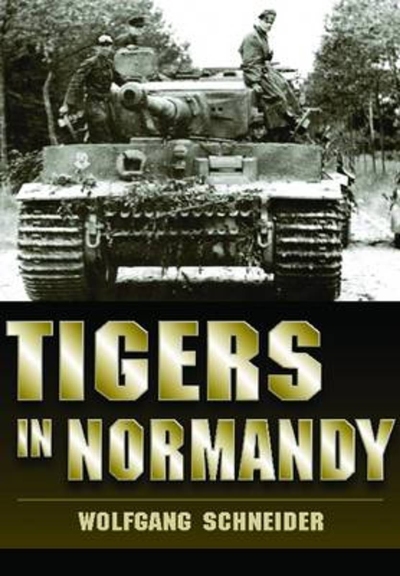| Title: | Tigers in Normandy |
| Writer: | Schneider, W. |
| Published: | Pen & Sword |
| Published in: | 2012 |
| Pages: | 376 |
| Language: | English |
| ISBN: | 9781848848023 |
| Description: | "Tigers in Normandy" by Wolfgang Schneider and published by the Pen and Sword Publishing company in the UK is an excellent book that meticulously traces the whereabouts of all German Tiger tanks in Normandy during and after the allied invasion. It was originally written in German and published in 2004 under the title "Tiger im Kampf: Die Einsästze in der Normandie". Schneider, a colonel in the present German army, has done a lot of research and included many accounts by soldiers involved at the time. Especially interesting is the fact that this book is not only about German tanks and troops, but also viewed, analyzed and written by a German officer, whereas the majority of history books and movies dealing with this period and battlefield are always seen from the ‘allied side’. And although it focuses on the German side of the battles and operations, it is not ‘taking sides’ as such and Schneider provides some interesting analyses of some of the people and their actions. The book follows a chronological path and the first thing that is flagged is the fact that there were no Tigers in the area on June 6th. They were not anywhere near even, and although one unit happened to be on its way to Normandy, the others were not. Subsequently they had to start their voyage towards the new front and that was not an easy one! By then the German Luftwaffe was of course not a major force anymore, so the allied fighters and bombers were almost freely roaming the skies. With most rail tracks damaged by bombing and sabotage, the tanks had to take to the roads. And these were constantly under fire from ground attack aircraft, forcing the tanks to drive at night and hide during the day. The Tigers were not only hampered in speed because of this, but they suffered from another problem too: tanks are not made to travel larger distances, certainly not in that era, and the wear and tear on the heavy equipment caused them to break down almost daily! It ultimately resulted in many tanks not being battle-ready. The book shows where all units were on June 6th, their routes to Normandy and some of the ‘adventures’ along the way getting there. The next major event is the famous ‘battle’ in Villers-Bocage, where Michael Wittmann hit on the British and Canadian troops on their way around Caen. Schneider calls this chapter "The Mystery of Villers-Bocage" and provides a very detailed account and analyses of Wittmann’s actions. This too is an interesting part of the book for those not intimately involved in the tank battles of Normandy. The author argues that the widely held views on that particular engagement on June 12th 1944 are often incorrect, depicting Wittmann as a brilliant tank commander with a supernatural action that day. In reality it may well have been that Wittmann acted haphazardly and not very wise, although courageous, and Schneider also shows that the actual number of allied tanks and other vehicles destroyed by him were much less than is usually assumed. Really to be liked about the book are the many, many photographs! And not only the old ones, but also the comparison photos showing old photos followed by ones of the current day situation. Sometimes it is amazing to see how little has changed in these past 69 years. There are also many detailed maps annotated with the positions and movements of the units involved and also the maps showing where photos were taken and in which direction. It results in lots of leafing backwards and forwards to acquire the situational awareness to go with the written accounts of the action. The book covers all the main (allied) operations that took place from June 6th (Operation Neptune of Overlord) through the final breakthrough of Falaise. In the Appendix section we find a list with allied units that took part in the various operations, an overview of all the Tigers of the Heavy Armor Units 101, 102 and 503 and a listing of the losses of these. It would have been nice to also have a chapter with some photos, specifications, explanation and maybe some cut-outs showing the workings and the innards of these formidable tanks. That would have made the work really complete. Other than that: highly recommended as part of the overall view on what happened in Normandy back in 1944! |
| Rating: |      Excellent Excellent |
Information
- Article by:
- Francois Dumas
- Published on:
- 05-10-2019
- Feedback?
- Send it!




